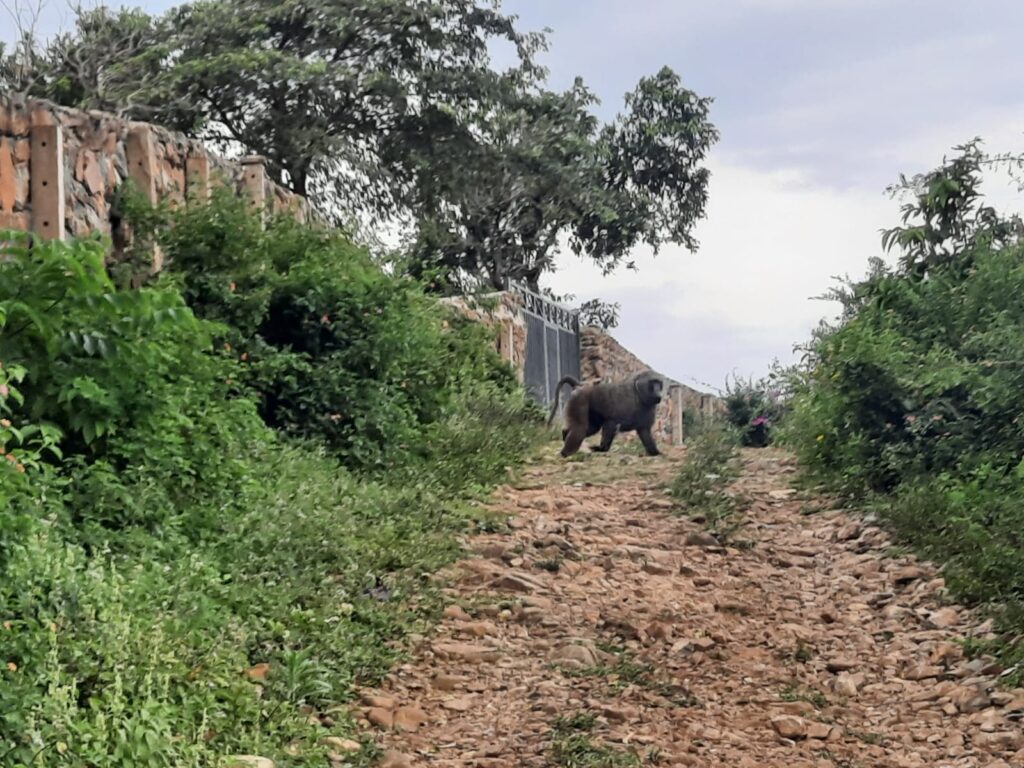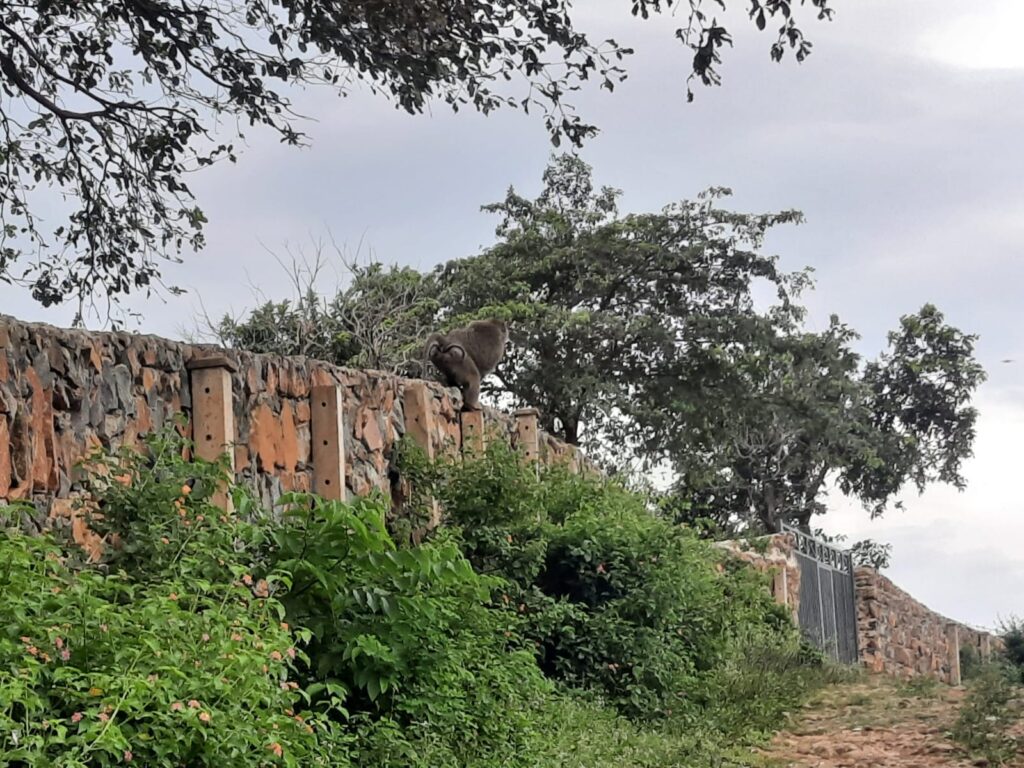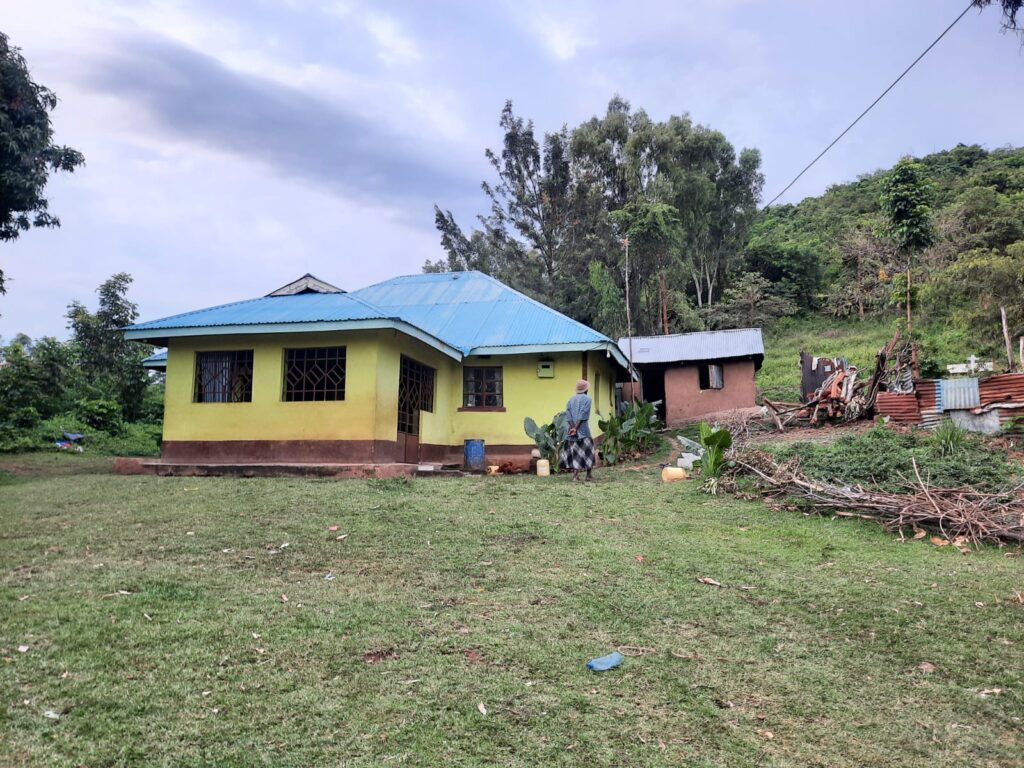It is a sunny Saturday evening at Kogony village in Kisumu West Sub County.
At the foot of Riat hills, baboons can be seen jumping with cracking laughter.
Dorcas Jerop appears from a nearby children home.
She has been working here since 2012.
Today, she is guarding newly constructed water taps near the hostels.
She says the taps were repaired a few days ago after they were damaged by the animals.
It is not the first time the institution is repairing the taps.
“The baboons destroy these taps while looking for water,” she says while dropping a stone which she would have otherwise used to chase the primates.

Baboons like to hangout in groups of about 50.
They live in savanna, semi-arid habitats while others in hot tropical forests across the world.
These groups consist of seven or eight males and many females.
The females don’t leave the core of the troop while males leave their natal troops.
So organized are the baboons that every group has a leader.
As the males grow, they move to different troops to build their relations and learn leadership skills.
Once they mature enough and learn the leadership skills, they take over the throne.
The same case is here. The villagers have even given them names.
Willis and Bill
From a distance we spot Willis, he is the hugest of them all.
Jerop says the children named him Willis after one of their classmates who was bigger than them.
“He commands them. He is occasionally friendly to us and he helps us chase his colleagues whenever they invade our premises to look for food or cause havoc in our small farms,” she said.
Today, another team led by Bill is not around. They are probably raiding the neighbouring village.

“When they meet here, they usually fight and the strong team stays for quite some time before the others come back,” she narrates.
The institution cannot practice any form of agriculture.
Their efforts to plant crops are always ended by baboons who raid the small farms.
The situation worsens when they break for holidays as the baboons destroy the roofs and windows while jumping from one hostel to another.
About 30 minutes later the baboons gather again at the fence.
I sometimes have to leave the taps running so that they don’t destroy them while looking for water because we can’t guard it 24 hours
Jerop
This time we are able to see the entire troop.
They seem to be keen on our movements just to see if we could bend to pick a stone to throw at them.
Jerop says they want the baboons rehabilitated to reduce the invasion.
“All they need is food and water,” she says.
“I sometimes have to leave the taps running so that they don’t destroy them while looking for water because we can’t guard it 24 hours,” she furthers.
She says the institution occasionally report the invasion to Kenya Wildlife Service.
We draw closer to the baboons but they quickly dash into the nearby bushes.
When mzee used to be there he could at least plant maize and stay alert whole day to guard it from the baboons until we harvest
Rose Yier
No help
We move to the nearest home, about 300 meters down the hill.
There is no plantation, just houses with bare fields but the trees and vegetation around prove that the soil is fertile.
Here we meet Rose Yier.

She has had a rather bad experience with the baboon menace.
She has lived here since 1966 when she got married to the late Lucas Yier.
What she has not enjoyed since the demise of her late husband is the joy of harvesting maize from her farm.
“When mzee was alive, he could at least plant maize and stay alert whole day to guard it from the baboons until we harvest,” she said.
But even now that they have no crops, the baboons still raid their homes to look for food.
These creatures kill our dogs, and when they get wild, they even attack humans
Rose Yier
The villagers only rely on dogs to protect their homes.
Ms Yier however says that these dogs usually sustain serious injuries while keeping the enemy at bay.
“These creatures kill our dogs, and when they get wild, they even attack humans,” she said.
Over the years she says that the community has gathered to chase the baboons but it only takes two weeks or a month before they come back.
The government has not done much to help us except sending officers to shoot in the air to scare away the animals which do not help
Rose Yier
Game Reserve
She however blames the government for not taking serious measures to contain the rogue animals despite several visits by the villagers to the KWS offices.
“The government has not done much to help us except sending officers to shoot in the air to scare away the animals which do not help,” said Rose.
The villagers now want the animals to be driven to a game reserve where they can be contained.
We can’t do farming around this place because baboons will invade and destroy the crops but with the cost of goods going up, we need to at least cultivate crops to sustain ourselves
Ombaka
With the cost of living shooting high they are calling for immediate government intervention so that they can practice agriculture to sustain their livelihood.
“We can’t do farming around this place because baboons will invade and destroy the crops but with the cost of goods going up, we need to at least cultivate crops to sustain ourselves,” said Hillary Ombaka who comes from a neighboring home.
Senior Warden Christine Boit said the number of baboons in the area was approximated at 36 in 2020 but has tremendously increased over time.
She said KWS has been controlling the primates through various strategies including continuous patrol in areas and setting up traps.
In 2020 we set up eight traps in the villages and managed to capture six baboons and transferred them to Ndere Island,” said Boit.
She however accused the villagers of stealing the traps, making their efforts to control the baboons futile.
“We trusted the community and left the traps, unfortunately we have not managed to get any trap,” says Boit.
According to Boit, the first case of invasion was reported in 2010 along the Riat hills.
The baboons were captured and relocated, calming down the situation and leaving the residents at peace.
Stolen traps
In 2017, it resurfaced in the Akingili area and KWS had to engage the community by identifying chiefs and scouts who reported the matter to the office.
“We did baboon controlling and eliminated the notorious ones,” said Boit.
In 2020, they strategized on better ways and made traps for the monkeys and baboons in Akingili.
However, the residents have complained of the increasing number of baboons.
According to KWS, the community has played a major role in collaborating with KWS to assist in any issue relating to conservation.
Each sub county has community representative who form County Community Wildlife Conservation Committees who are gazetted by the government to solve conflict in the areas.
Scouts are also recruited to report any conflict arising in any area to KWS office.
The scouts in the area have however failed to recover any traps with the number of primates terrorising the residents is slowly increasing.
“I’m appealing to the community to be supportive and help us identify individuals who steal the traps,” said Boit.
As part of the long-term solution, Boit revealed that they are having engagements with the community to convert the area into a cultural centre and hiking area where people can visit to have a view of the baboons.
This, she says can turn the community members into entrepreneurs and is on research by experts as part of the long-term solution to the problem
